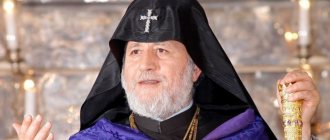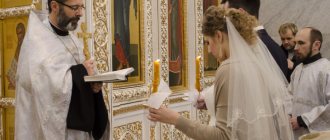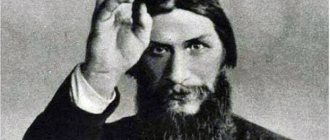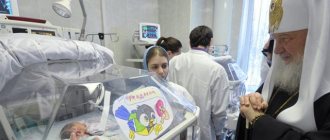The concept of ecumenism
Ecumenism translated from Greek means “to inhabit”, “to dwell”. Initially, “ecumene” was the name given to the territory developed by people. Therefore, “ecumenical” is “universal”, referring to all humanity.
The modern concept of “ecumenism” came into use at the congress of the “International Missionary Council” at the beginning of the twentieth century. The author of the idea is the famous Protestant preacher John Mottom (1865 – 1955). His ecumenistic views became widespread among Protestants. Subsequently, they became popular among various religious movements in Europe and America.
“Temple of All Religions” (Kazan, Russia)
Definition of ecumenism
The word “ecumenism” comes from the Greek oikoumene, which translated into Russian means “promised world, Universe.” The meaning of the name of the worldview fully justifies its policy aimed at creating a universal Christian belief capable of uniting all categories of the population.
The main Divine message—the Bible—calls us to unity. The Gospel of John (17, 21) speaks of the commandment “That they all may be one.” The Bible Society has strived for interfaith unity throughout its existence, and ecumenism is a way of realizing the boundless hopes for religious integration.
The basic, doctrinal basis of ecumenism is the belief in the Triune God. “Jesus Christ is our Lord and Savior,” this is the unanimous dogmatic minimum of the ecumenical worldview.
Directions of ecumenism
Ecumenism is the idea of bringing together different religious movements into one community (community). The idea of ecumenism also claims to have a “universal” scale. However, true faith is replaced exclusively by a mechanical unification of various religious movements that have fallen away from Orthodoxy. It has three main directions.
First direction
Constructive dialogue between Christian communities aimed at joint preaching of the Gospel in the non-Christian world. Also an important task is to counter the negative aspects of modern paganism. An example of such cooperation is the Christian seminar “Totalitarian sects in Russia” held in 1994. On it, Christians of various denominations described as an anti-Christian initiative the unification of Christianity with “occult” and Eastern beliefs.
“If some religious or “cultural” group says about itself that it has found a way to synthesize all the world’s religions, this is a clear sign that we are not dealing with an “all-reconciling teaching.” This is a sect that is trying to plant a pseudo-Eastern cult under the guise of sympathy for Christianity” (final report of the seminar).
Second direction
A liberal movement based on the desire to unite various Christian denominations into a common Church. Ecumenism in this understanding originates among Protestants. The essence of the so-called “branch theory” is that Christians, no matter what Church they belong to, have a common faith in Christ crucified and risen. Therefore, despite significant differences in dogma, all Christians are members of one Church.
Such a unification, according to supporters of this idea, would only bring benefits in the spread of Christianity. Moreover, it could enrich and diversify each other's culture. Drawing together presupposed common prayer and shared Communion.
Third direction
The doctrine of the unification of all world religions into a single religious system, in which God is presented as the “highest mind” and “absolute”. Thus, it is proposed not only to remove all contradictions, but also to eliminate all the features of different religions.
Let's talk about ecumenism as a desire to unite Christian denominations into one Church.
Russian Orthodox Church and the ecumenical movement
| Archpriest Maxim Kozlov |
Before talking about the participation of the Russian Orthodox Church in the ecumenical movement, some clarifications should be made. In the proper sense of the word, the ecumenical movement is understood as a movement of numerous, mainly Protestant, denominations that declare as their goal the achievement of the most complete unity between followers of various Christian denominations. The first conference of different Christian denominations was the World Missionary Conference in June 1910 in the city of Edinburgh, one of the commissions of which was called “Cooperation in the Field of Achieving Unity.” The conference took place without the participation of Orthodox representatives. Almost simultaneously, in October 1910, at the annual conference of the American Episcopal Church in Cincinnati (United States of America), a resolution was adopted to form a special commission to convene a world conference on issues of faith and church structure. Hence this date, October 19, 1910, can, with a certain degree of convention, be considered the beginning of the ecumenical movement in the modern sense of the word. This decision subsequently led to the creation of the so-called World Council of Churches.
The decision to create the World Council of Churches (now a widely used abbreviation for the WCC) was made in May 1938 at a consultative conference in Utrecht (the Netherlands). And the first assembly of the World Council of Churches, held in 1948 in Amsterdam, essentially completed the process of organizing the ecumenical movement. Thus, in relation to the history of the Russian Orthodox Church before 1917, it seems generally difficult to use the term “ecumenical movement.” In this sense, the title of such books as “Orthodoxy and Ecumenism”, involving material from the 18th–19th centuries, is not entirely historically correct. It is advisable to talk only about interfaith contacts of the Russian Church. During this period in the history of the Russian Church, from the point of view of the topic we are considering, we may be interested, firstly, in the statements of authoritative hierarchs, theologians, and devotees of piety of the Russian Church, many of whom are now canonized, on issues relating to the attitude of the Orthodox Church to heterodoxy and issues of church unity and church communication, as well as, naturally, the official judgments of the hierarchy, the Holy Synod on these problems. Secondly, we should also be interested in direct contacts of the Russian Church with the heterodox world, both on a personal level (the famous correspondence of A.S. Khomyakov with Archdeacon of the Anglican Church William Palmer) and on the official level, contacts that had as their goal religious unity and establishment of full church communion.
First of all, it should be noted that the judgments of Russian theologians on these issues are characterized by an extremely insignificant range of opinions. Almost all Russian theologians define heterodox (Roman Catholics, Anglicans, Lutherans and others) as heretics and directly call them by this word. This is true even for such diplomatic and cautious authors as, for example, St. Philaret of Moscow. It is not possible to form a complete picture of St. Philaret’s position on this issue, say, on the basis of the thoughts expressed in his early work, “Conversations between the testing and the confident,” since this book, written in 1815 under certain conditions and with certain goals, reflects the still emerging views of the great hierarch and saint of our Church. Subsequently, the saint spoke about the heterodox, including Catholics, much more sharply: “Tolerance does not mean the recognition of heresy, but only the absence of persecution, allowing those of other faiths to remain in their natural religion, to remain stuck in errors until the light of grace illuminates them. Whether he is a Quaker or a Jew, a Herrnhuter or a Muslim, a pagan or a pagan.” Which pair - a pagan or a pagan - are on the same level! (M.K.) (Collected opinions and reviews. T. 4. P. 557).
It is also interesting to consider how Russian theologians resolved the question of the validity of the sacraments performed in heterodox communities. There are 2 main approaches to this issue. Some authors completely exclude the possibility of performing sacraments in a non-Orthodox Church and, accordingly, consider all non-Orthodox sacraments, with the possible exception of baptism, as graceless. This opinion was shared by Saint Ignatius (Brianchaninov), A.S. Khomyakov, Archbishop Hilarion (Troitsky), Metropolitan Eleutherius (Epiphany), and Metropolitan Anthony (Khrapovitsky). A position close to this was taken by Archbishop Seraphim (Sobolev), who, while recognizing the validity of such sacraments as anointing or priesthood, nevertheless refused to recognize their effectiveness, and therefore their salvific value.
The official position of the Russian Orthodox Church on this issue can be judged, for example, by the response message of the Holy Synod of the Russian Orthodox Church dated February 25, 1903 to the District Letter of Patriarch Joachim III of Constantinople, which states that the Russian Church recognizes the baptism of Western Christians and honors the apostolic succession of the Latin hierarchy. The majority of Russian theologians then adhered to this moderate position. The question of the attitude of the Russian Church to heterodoxy and the validity of the sacraments in communities separated from the Orthodox Church was developed in more detail in the works of His Holiness Patriarch Sergius (Stragorodsky). The essence of the views of Patriarch Sergius is briefly expressed in the words of this outstanding theologian of the Russian Church, who is not fully appreciated in everything: “Although indeed some sacraments are held by non-Orthodox people, although they have the right to the name of Christians with the ensuing consequences, although they remain within the boundaries of the church and even on the porch, yet they do not participate in the church Eucharist. There cannot be two Eucharists that do not communicate with each other, equally Christlike and equally true, just as there cannot be two Christs and two Churches.” Without pretending to make any generalizations, we can nevertheless note that as much as we studied this topic, we were unable to find either official documents of the Russian Church or statements of our authoritative theologians of the 19th and early 20th centuries, in which it was stated with any certainty that certain heterodox denominations possess the true Eucharist. The position on this issue of His Holiness Patriarch Sergius and the Russian Church was considered generally accepted, at least until the 60s. Thus, back in 1959, professor of the Leningrad Theological Academy Nikolai Uspensky on the pages of the ZhMP (No. 7 for 1959) characterizes the works of Patriarch Sergius as the last word of Russian theological science on the issue of the attitude of the Orthodox Church to heterodoxy. Thus, Russian theological thought at the beginning of the century did not make a fundamental distinction between modern Western Christians and heretics of antiquity.
Metropolitan Anthony (Khrapovitsky) wrote in 1915 that “...The Orthodox Church does not believe in any qualitative difference between the so-called heterodox Christians of Europe in secular language and the ancient heretics, for when the former express their desire to join the Church, the Roman Catholics are accepted into communion in the same order as the Arians, Nestorians, Monophysites and the like, and Protestants, as even more distant from the Church than the named heretics, through confirmation.” The consequence of this view of the heterodox world was the unconditional recognition of only the Orthodox Church as the true Church. The response message of the Holy Synod of February 25, 1903 states that the task of the Orthodox Church in relation to non-Orthodox people is to reveal to them the Orthodox faith and the truth that only our Eastern Orthodox Church, which has preserved intact the entire deposit of Christ, is currently the Universal Church. Naturally, the restoration of church unity was conceived only as the reunification of non-Orthodox people with the entirety of the Orthodox Church. At the same time, the achievement of complete unity in matters of doctrine was considered as an indispensable condition for the foundation of such a reunification.
In the message of Metropolitan Isidore of St. Petersburg, which in 1870 was sent on behalf of the Holy Synod to the American Episcopal Church, Fr. However, it should be noted that such a principled and consistent position of the Russian Church in matters of achieving inter-Christian unity was combined with tolerance, goodwill towards non-Orthodox people, openness to dialogue with them at all levels and with a sincere desire for unity. There has never been such a tendency, so characteristic of para-church journalism, to emphasize the shadow sides, to be satisfied with the state of division and one’s own correctness, while it can be assumed that numerous marriages of representatives of the Romanov dynasty with representatives of Protestant dynasties at one time had a softening influence on the position of the resolutions of the Holy Synod, and on the other hand On the other hand, the very possibility of these marriages was in the context of the theological approach to heterodoxy of the Russian Orthodox Church.
As for official inter-confessional contacts that were directly related to the issue of restoring communication with non-Orthodox people, during the period under review the Russian Orthodox Church did not have many of them. First of all, it should be noted the contacts with the Anglicans that took place as early as 1716–1720. Before that, one can only remember a peculiar dialogue between Tsar Ivan the Terrible and a Lutheran pastor. Tradition says that after a brief discussion about the comparative soteriological significance of faith and good works, the pastor had the imprudence to compare Luther with the Apostle Paul, after which the king stopped the discussion with completely non-theological arguments, hitting him with a whip, with the words: “Go (hereinafter not publicly quoted expression) with his Luther." At this point, communication with Lutherans ceased.
At the beginning of the 18th century, the question of reunification with the Russian Orthodox Church was addressed by a group of Anglican bishops, the so-called “non-sworn” bishops, who separated from the Anglican Church in 1690 after they refused to swear allegiance to King William III. Contacts with the Anglican Church intensified in the 60s of the 19th century due to the contact of both Churches on the northwest coast of America. The discussions about reunification continued until 1870, but did not lead to concrete results due to the fact that the parties viewed the essence of unification differently. The Anglicans previously sought practical unity based on communion in the sacraments, without attaching importance to dogmatic differences; the Orthodox did not allow unity without agreement in faith. Contacts with the Anglicans resumed at the end of the 19th century. Negotiations on the possibility of rapprochement took place in 1895–1897. At the beginning of the twentieth century, negotiations with the Episcopal Church in the USA were resumed with the participation of St. Tikhon, the future Patriarch of Moscow and All Rus', then bishop of the Russian Orthodox Church of North America. It should be said that Saint Tikhon personally treated representatives of the Episcopal Church very favorably. Two such very characteristic facts are known. This zealot of Orthodoxy and paternal traditions was once at the ordination of the Anglican Bishop Grafton in the city of Fond du Lac in the state of Milwaukee, was in a bishop's robe, stood in the apse of the altar of the Anglican church and prayed during this service (this photograph of St. Tikhon is very famous, it was published in the 1st volume of the “Orthodox Encyclopedia” in an article about the Anglican Church) and it is also known that when a terrible earthquake occurred in California, St. Tikhon sent one of the parishes with which he had previously had direct communication as a gift of the Eucharistic vessels, which clearly demonstrated his attitude to the then Episcopal Church in America. But let us emphasize that it was precisely in that time, and not in what it has become now, at the beginning of the 21st century, having introduced not only the female episcopate, but also having recently ordained an open “bishop” -pervert, after whom our Church was forced to withdraw from all dialogues with the Episcopal Church of the United States of America.
In 1894–1914, the Russian Orthodox Church also conducted a theological dialogue with Old Catholics, which was carried out within the framework of the so-called St. Petersburg-Rotterdam Commission. However, these attempts were not crowned with success. The ultimate goal - the restoration of church unity - was not achieved. Speaking about interfaith contacts, which are directly related to the restoration of church communion, we have to admit that in the Russian Orthodox Church before 1917 they were mainly of a random nature. On the other hand, their very initiative more often came from the heterodox side. It is historically impossible to talk about the participation of the Russian Church during this period in some movement aimed at achieving inter-Christian unity. In addition, it should be recognized that at this time the Russian Church did not have any developed concept of such participation. However, the need for such a concept was undoubtedly felt at the beginning of the twentieth century, which was reflected in the decisions of the Local Council of 1917–1918, within the framework of which the Department of the Unity of Christian Churches operated. At the last meeting of the Council on November 7–20, 1918, it was decided to continue the dialogue on unity with the Anglicans and Old Catholics, based on the doctrine and traditions of the ancient undivided Church. The council's resolution prescribed the creation of a permanent commission with branches in Russia and abroad to study disagreements on the path to unification with the Anglicans and Old Catholics. The commission was tasked with ensuring the speedy achievement of the set goal for church unity. However, it is clear that subsequent events in the post-revolutionary years certainly prevented these decisions from being implemented.
In the period 1917–1945, international contacts of the Russian Orthodox Church were reduced to a minimum. Russian church emigration did not have a unanimous opinion on the issue of participation of the Russian Orthodox Church in the ecumenical movement. The Synod of the Russian Church Abroad has taken an irreconcilable position on the issue of attitude towards ecumenism in all its forms. At the same time, part of the Russian Church in Western Europe, which was under the omophorion of Metropolitan Eulogius (Georgievsky), quite actively participated in the ecumenical movement. However, this part, firstly, was completely isolated from the Russian Church in the USSR, and secondly, it was too small in number to be able to adequately express the position of the entire Russian Church. In addition, since 1930, this part was actually in schism and, therefore, did not have the right to speak at ecumenical events on behalf of the Russian Church, which was rightly pointed out at the meeting of heads and representatives of Autocephalous Local Churches in Moscow in 1948. Direct interaction of the Russian Orthodox Church with the ecumenical movement in the proper sense of the word begins as the Moscow Patriarchate resumes international contacts after the end of the Great Patriotic War. In the face of the ecumenical movement, especially the one that was rapidly gaining strength in the WCC, our Church was faced with a qualitatively completely new phenomenon, which had no analogues in the history of interconfessional contacts of the Russian Church before 1917, which posed a number of serious problems of both theological and practical nature to the Russian Church . The ecumenical movement of the mid-twentieth century differed from the practice of inter-Christian contacts of the early twentieth century both in form and in spirit, and in goals, and in the means of achieving these goals.
Interfaith contacts of the 19th and early 20th centuries were bilateral dialogues. The parties participating in them were completely free and independent of each other. In the mid-twentieth century, ecumenism was a worldwide movement with a specific structure, the core of which was already the World Council of Churches. Integration into this movement automatically made this or that Church part of a huge whole and inevitably imposed on it certain obligations, the acceptance of which could be in conflict with its tradition. Thus, for the Russian Church, the question of the permissibility of Orthodox Christians to participate in joint ecumenical prayers with non-Orthodox Christians became especially acute at that time, since by this time these prayers had become an integral part of ecumenical events. The structural design of the ecumenical movement forced us to approach the question of joining it with the utmost caution, because it was already obvious that joining it would be much easier than leaving back. The very spirit of this movement could not help but confuse the Orthodox. When they talk about the entry of the Russian Orthodox Church into the ecumenical movement, they point to the experience of the participation of the Russian Church in inter-Christian contacts at the beginning of the twentieth century, in particular to the activities of St. Tikhon that we mentioned, as a historical precedent, but they lose sight of the fact that these were not exactly the same heterodox ones. The Anglicans and Old Catholics with whom the Russian Church negotiated at the beginning of the century were then the heterodox closest to us, who were also sincerely interested in Orthodoxy and were thinking about reunification with it. For example, the head of the Episcopal Church in America, Bishop Grafton, in his article “The Union of the Eastern and Anglican Churches,” called on all Anglican bishops to accept the Orthodox faith in its entirety. Well, why not communicate with such a person? Is it even possible to imagine that any of the modern Protestant representatives, the leaders of the World Council of Churches, would make such an appeal? In the middle of the century, the tone in the ecumenical movement was set by the Protestant majority, which was internally alien to Orthodoxy, and did not show serious interest in it.
The only goal of the dialogues of the Russian Church with non-Orthodox people in the 19th and early 20th centuries was the restoration of full church communion, the achievement of which was thought possible only on the basis of complete unity in faith. In the ecumenical movement of the mid-century, achieving unity in faith was only one of the goals of the movement, and not always the dominant one. As we have already seen, Russian theological thought at the beginning of the century understood the restoration of church unity only as the reunification of non-Orthodox people with the entirety of the Orthodox Church. Naturally, such an approach was completely alien to the Protestant majority in the ecumenical movement of the mid-century, which in the question of church unity was inspired by the ideas of interconfessionalism or the so-called branch theory, therefore it was very difficult for the Orthodox to accept the very term “ecumenical”, at least in that sense , which is invested in it by ecumenists.
The definition of “ecumenical” was given at the Second World Conference of the Life and Order movement in June 1937 in Oxford. I quote this definition: “The term “ecumenical” refers to the expression in history of the unity of the Church. The consciousness and actions of the Church are ecumenical, since they are aimed at realizing the one holy Church, the brotherhood of Christians recognizing one Lord.” It’s as if this Church is not on earth! The then General Secretary of the WCC, Dr. Visser't Hooft, explained the meaning of this term in a similar way: “The following reasons seem to explain the widespread acceptance of this term. It could determine the nature of the modern movement of cooperation and unity, which seeks to reveal (!) the basic unity and universality of the Church of Christ.” Again, the classic Protestant idea is to reveal unity, as if it were not manifested in the historically present on earth of the Universal Church of Christ. Thus, the undoubted fact for every Orthodox Christian of the real existence of the one holy catholic apostolic Church, the faith in which we profess in the ninth member of the Creed, in this case is posited as a goal that must still be identified and realized.
Due to the above circumstances, the Russian Orthodox Church could not help but raise the question of how possible and justified Orthodox witness is in such conditions. Can it give positive results, and will it not harm the Russian Church itself? The extent to which these fears were justified is evidenced by the recognition of Protopresbyter Alexander Schmemann, who had extensive personal experience in the ecumenical movement, rather supported it, but nevertheless, towards the end of his life, made the following statement: “A characteristic feature of the participation of the Orthodox in the ecumenical movement is that that the Orthodox were left with no choice, in that from the very beginning they were assigned a very specific place, role and function within the ecumenical movement. This appointment was based on Western theological and ecclesiological premises and categories and betrayed the purely Western origin of the ecumenical idea itself” (published in the article “Ecumenical Pain” in the collection “Church, World, Mission” M, 1996, p. 235). And two more small quotes from the same Schmemann: “Anyone who has seriously studied the ecumenical movement could be convinced that Orthodox testimony (expressed mostly, if not exclusively in the form of individual statements of Orthodox delegations attached to the minutes of the main ecumenical conferences) has never provided any noticeable influence on the orientation and theological development of the movement as such” (pp. 237-238). “The questions that the West proposed to the Orthodox were formulated (we quote another statement by Schmemann) in Western terms and reflected the specific Western experience and path of development. The answers of the Orthodox were built on Western models, adjusted to categories that were understandable to the West, but hardly adequate to Orthodoxy” (p. 247). This largely determined the internal characteristics of the ecumenical movement. The internal adequacy to Orthodoxy of the answers that were forced to be given in these ecumenical dialogues is questionable.
(End to follow)
Is ecumenism a common faith in Jesus Christ or a delusion?
Rev. Paisiy Svyatogorets (1924 - 1994) to the question “what is ecumenism?” answered:
“The devil has cast a net to catch all of humanity. He wants to catch the rich with Freemasonry, the poor with communism, and the believers with ecumenism.”
For the first time, the ideas of ecumenism were condemned by the Russian Orthodox Church in 1621 by Patriarch Philaret (Conciliar Exposition of 1621 on Baptism Latin). At the same time, the idea of rapprochement between Orthodox and Catholics was widespread among the Greek hierarchy and clergy. Later, during the European Reformation, the idea of the spiritual unity of all Christians was shared by many Protestant communities.
Nowadays, “Christian” ecumenism is gaining increasing momentum among people who consider themselves followers of Christ. Most often, adherents of this idea do not delve into the study of the Holy Scriptures and the doctrine of the Orthodox Church.
““Christian” ecumenism rests on a vague but nevertheless very real sense of a “common Christianity” shared by many who do not think particularly deeply about the Church and are not particularly passionate about it, and its goal is to “create” a church that unites everyone such indifferent Christians... “Christian” ecumenism in its best version represents a sincere and understandable delusion of Protestants and Catholics - a delusion that lies in the fact that they do not know how to understand that the visible Church of Christ already exists and that they are outside of it” ( Hieromonk Seraphim (Rose)).
Attitude of church leaders
The opinions of Orthodox leaders regarding this issue vary; for example, Deacon Andrei Kuraev claims that ecumenism is not a heresy. And although most Orthodox leaders do not agree with him, he argues that this movement is just an interfaith dialogue and exchange of theological experience. Therefore, Kuraev views it as a positive and necessary phenomenon.
Patriarch Kirill is also close to recognizing it as a positive phenomenon, since he often spoke about the need for dialogue with other faiths and personally participated in such meetings (meeting with the Pope, for example). Although he understands that in the Orthodox world there is strong opposition and rejection of this movement. Because of this, as well as the extreme isolation of Orthodoxy, Patriarch Kirill often withstands harsh criticism of himself, especially after his words in defense of ecumenism.
“Ecumenism” what is it in Orthodoxy?
Ecumenistic initiatives are still seriously considered in many Christian Churches today. Thus, Pope Francis I proposed to determine a common date for Easter for all Christians. And this despite the fact that the rule of the First Ecumenical Council (325) clearly outlines the criteria for determining the date of the Resurrection of Christ and does not provide for any changes.
To this, Patriarch Bartholomew of Constantinople replied that he sees benefits in such a reform
“for Christians living in America, Western Europe and Oceania” and “in recent years, and especially after the fall of the Iron Curtain, some forces in some national Churches, unfortunately, oppose this idea of reform” (from an interview with the Italian newspaper La Stampa).
In the Russian Orthodox Church, the majority of clergy do not see a real possibility of uniting Christian denominations for common prayer and participation in the Eucharist. After all, the apostolic canon says: “If anyone prays with someone who has been excommunicated from church communion, even if it were in the house, let him be excommunicated” (10th canon of the Holy Apostles).
“Not uniting with heretics, wherever their center is, in Geneva or in Rome, our Holy Orthodox Church, always faithful to the Holy Apostles and Fathers, will not thereby abandon its Christian mission and evangelical duty, i.e. it will be before the modern Orthodox and non-Orthodox worlds humbly but boldly testify to the Truth of the All-Truth, the living and true God-man and the all-saving and all-transforming power of Orthodoxy. The Church, led by Christ, through its patristic spirit and theologians, will always be ready to give an account of our hope to everyone who demands an account (1 Pet. 3:15)” (Rev. Justin (Popovich) “Report to the Holy Synod of the Serbian Church”).
It must be admitted that some priests of the Russian Orthodox Church are loyal to the trend of rapprochement with Catholics. The most famous example is Archpriest Alexander Men.
What is ecumenism from the point of view of Orthodoxy
The Orthodox Church today is the most conservative branch of Christianity, since all new trends in the Orthodox Church are perceived with suspicion and rejected by the majority of Christians (the most striking example is the refusal to switch to a different calendar). Nevertheless, the Orthodox Church is ready for interfaith dialogue, despite the statement in the “Basic principles of the attitude of the Russian Orthodox Church to heterodoxy” that only Orthodoxy has full Divine grace. This statement leads to the idea that Catholics and Protestants should repent and return to the bosom of the true church.
Ecumenism is expressed in holding interfaith congresses and conferences, joint prayers and worship services
Thus, ecumenism is a harmful and, most likely, unnecessary phenomenon for Orthodoxy. If we cooperate with other religions, then only on the basis of Orthodoxy. Many Orthodox theologians believe that ecumenism not only does not provide any benefit, but is impoverishing due to its mechanicalness and depersonalization. Only the Lord can unite.
Read about the Orthodox Church:
- Is it possible for Orthodox Christians to go to churches of other religions?
- Priest, priest and priest - what's the difference?
- On ordination to the priesthood
Why does the Orthodox Church deny ecumenistic ideas?
The Creed clearly states the doctrine of the true Church of Christ:
“I believe in one, holy, catholic and apostolic Church.”
Here we are not talking about a new united structure, but about the existing and unchanged Orthodox Church for many centuries. This Church was created on the rock of Christ's Truth, and not on the sand of all kinds of heresies and errors. The Church would not be united if arbitrary approaches to dogma were allowed. Actually, the result of such interpretations has a historical example - the presence of a huge number of Protestant movements.
Ecumenists reject the immutable apostolic rules (10th and 45th). They talk about the impossibility of prayerful communication with heretics. And any Orthodox Christian who deviates from this prohibition must be excommunicated from the Church.
Ecumenism also tends to belittle the significance of the patristic works. It is presented as human creativity, not divine revelation. Sacred Tradition ceases to be Sacred, it is no longer considered as authority. The first place is given to interpreting the Bible at your own discretion, which leads to significant misconceptions.
Such a view is alien to Orthodox doctrine, since divine truth has remained unchanged for more than 2000 years. In ecumenism, true impartial faith is replaced by a “convenient” surrogate. There is an opportunity to adopt “unmodern” dogmas and establish their own rules.
Chronicles: a history of ecumenism
Despite the fact that the emergence of ecumenism dates back only to 1910, at the beginning of the two-thousand-year history of Christianity, institutions preaching this religion were called ecumenical councils, and the Patriarch of Constantinople awarded heroes with the “ecumenical” title. Nevertheless, the desire for universal unity constantly competed with religious fragmentation, which ultimately led to the emergence of such new formations as schisms, sects and branches of Christianity. So, ecumenism is a religion with a history.
The Church began searching for a solution to the problem in the 10th century, when the Edinburgh Missionary Conference was held. At the meeting, issues of the importance and priority of interdenominational interaction across any religious boundaries were discussed.
The observable history of ecumenism continued in 1925. At one of the General Christian Conferences, the question of a general Christian position and ways of its social, political or economic propaganda was raised.
Three years later, Lausanne (a city in Switzerland) hosted the first World Conference on Faith and Church Order. Its theme was devoted to the founding of basic Christian unities.
Subsequent meetings in 1937-1938 were held with slogans about Christian unity, in England and the Netherlands, respectively. During these years, the World Council of Churches was created, whose meeting, due to the outbreak of World War II, could only be held after 10 years.
Conducting bilateral meetings and theological dialogues between Churches with different traditions and confessions can be considered the main achievement of ecumenism.
Interpretation No. 2. Liberalism in ecumenism
Ecumenism calls for pan-Christian unification. The liberalism of the movement consists in the desire, according to the Orthodox Church, to create artificially a new belief that will contradict the existing one. Ecumenism with a liberal bias has a negative impact on apostolic succession and dogmatic teachings. The Orthodox Church hopes to see a pro-Orthodox ecumenical movement, which, based on recent events in the world of ecumenists, is impossible.
Interpretations of ecumenism
Ecumenists do not position themselves and their sentiments as a creed, ideology or church-political movement. No, ecumenism is an idea, a desire to fight against the schism between those who pray to Jesus Christ.
All over the world, the semantic load of ecumenism is perceived differently, which, in turn, affects the problem of creating a final formulation of the definition of this movement. At the moment, the term “ecumenism” is divided into three semantic trends.
Does ecumenism support world Christianity?
Ecumenism in the Orthodox Church strengthened in 1961, after the Russian Orthodox Church joined the World Council of Churches.
Catholic Christianity is characterized by an ambiguous attitude towards the ecumenical movement: despite the fact that representatives of the Roman Catholic faith have not declared a complete rejection of ecumenism, they are not part of it. Although, the Second Vatican Council of the Roman Catholic Church, which seemed to take a position reminiscent of the movement against ecumenism, emphasized the unnaturalness of division. “Schisms are at odds with the will of Christ,” stated the 1964 decree “On Ecumenism.” In addition, it is worth noting that leaders of this branch of Christianity take part in the activities of the “Faith and Church Structure” commission.











